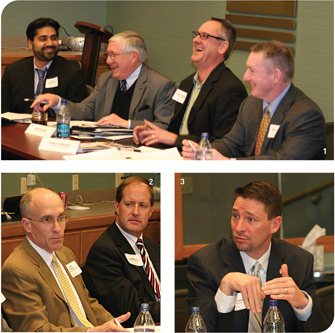
1: Jim Delaney, second from left, broke up the room with a wisecrack about what it took to get through high school. | 2. With Don Greenwell looking on, John Foudray of Neighbors Construction said that among the major lessons of the construction downturn were the need for project diversity and keeping overhead under control. | 3. Parker Young said that Straub Construction, like other companies, had invested in its work force even during the slowdown, in order to be ready to respond to new opportunities at recovery’s onset.
For Scott Vath and several others, the primary challenge was “getting the right people back on board.” He is concerned that during the downturn, many skilled people chose to leave the industry for good.
“That’s always been my concern,” agreed David Kendrick. He expressed
particular worry about the “middle level”
of employee. Many of them “have just gone on to other pastures.”
Don Greenwell subscribes to a theory of creative destruction. “We go through a period where we assemble resources, and they explode a bit, and they reassemble themselves,” said Greenwell. In the long run, he sees this as good for America. In the short run, however, he expects to see a decrease in productivity because it will take time to get new people up to speed. He hopes that new technologies will help compensate.
According to Jim Delaney, Turner Construction has kept a stable work force so that when the market turns, “We are ready to pounce on it, and we can sell the concept that we have the capabilities.” His fear is that competitors will try to lure away his good people. Many of those competitors, however, have hewn to the same strategy as Turner has.
Straub Construction is one of them. “We’ve followed exactly with Jim,” said Parker Young. “We’ve maintained and spent the dollars to make sure our team is assembled and experienced.”
Mark One Electric is another. “If you don’t take care of your people now,” said Joe Privitera, “they are not going to take care of you when the change is there.” He argued for the necessity of ongoing training and education. Added Rosie Privitera Biondo, “We have actually hired on with the intent of bidding more and trying harder.”
Rick Maniktala offered a useful caution. He observed that profit margins had eroded as the economy turned down, and would not snap back quickly. “So in order to ramp up,” he added, “we are all going to have to learn to be very lean.”
Lessons Learned
In the spirit of creative destruction, Rosie Privitera Biondo asked her colleagues what lessons they had learned during the down years.
“I think we’ve all learned to do a little bit more with a little bit less,” Brett Gordon said succinctly. This involves maximizing staff efficiency and doing extra estimating to chase the extra work.
Randy Bredar believes that coming out of the slowdown, the structure of project delivery will have changed considerably. He expects to see the entire industry, from design through project completion, becoming more efficient.
As David Rezac explained, 360 Architecture used the down time for a little “self-reflection.” The firm evaluated its management and execution processes and enhanced its training and professional development. “We’ve really taken a hard look at the way that we do business,” said Rezac.
“I think the lesson is you can’t let your overhead get out of control,” said John Foudray. He sees no reason why overhead should be higher in flush times than in fallow ones. He also argued for a diversity of work.
Susan McGreevy believes that her clients have become more cautious in a useful way. “They’re actually reading things before they sign them,” she cracked, “and they’re taking objection to things that they just don’t believe they can sleep at night having signed.”
One lesson that property owners have learned, as Tom Vrabac noted, is the importance of liquidity. “When you get into the really bad markets like we’ve seen,” said Vrabac, “cash is what bails you out. The players that are buying properties today are the ones with cash.”
David Rezac has appreciated the refinements in technology that are emerging. He was referring specifically to the software that allows for integrated delivery of the various disciplines—architecture, engineering, construction—that comprise the industry.